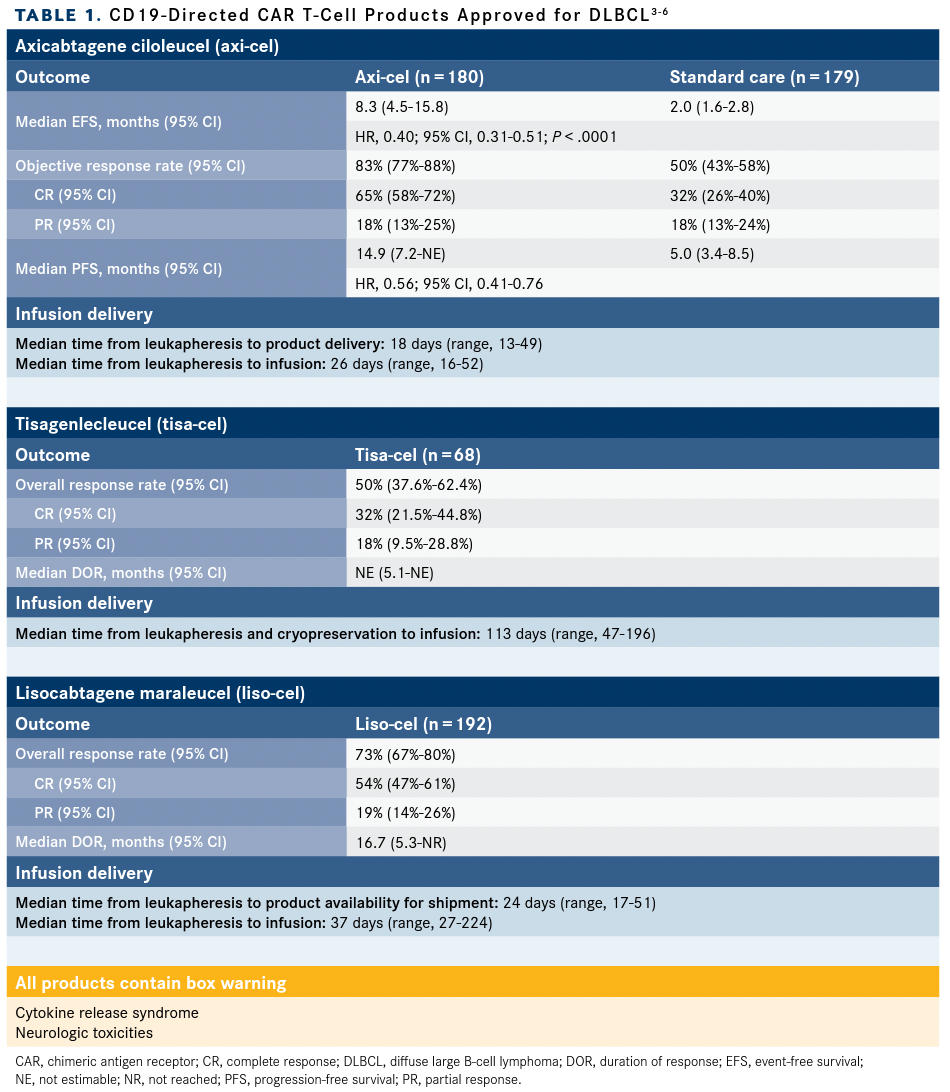Publication
Article
Oncology Live®
New Treatment Options Are in Play for Relapsed/ Refractory DLBCL
Author(s):
Up to 40% of patients with diffuse large B-cell lymphoma are refractory to or relapse after first-line treatment.
Jason Westin, MD, of MD Anderson Cancer Center

Up to 40% of patients with diffuse large B-cell lymphoma (DLBCL) are refractory to or relapse after first-line treatment.1 Although CD20 once served as a promising target, patients with DLBCL often developed resistance or did not respond to targeted frontline treatments, which led investigators to uncover other pan–B cell targets in the first- and later- line settings.1,2 The likelihood of cure decreases with each relapse, and disease refractory to second- or later- treatment lines is associated with a survival of less than 5 years.1,2 For most patients, high-dose chemotherapy and stem cell transplantation remain the standard of care in the second line. However, treatment options are expanding with CD19-directed chimeric antigen receptor (CAR) T-cell therapies and monoclonal antibodies (mAbs), several of which have been approved by the FDA in the past 5 years.
“We’ve gone from a disease where the curve kept dropping and patients kept relapsing and dying of their cancer to where we’re curing at least a subset,” Jason Westin, MD, said during a recent OncLive Peer Exchange®. “It’s very gratifying to see these novel approaches begin to bear fruit, and the idea of adding our amazing new targeted therapies to 1970s chemotherapy. I’m hopeful that we can start having novel-novel combinations in the front line [and] I’m quite intrigued by the potential for moving CAR T cells to even earlier lines.”
Grzegorz S. Nowakowski, MD

Westin was joined by a panel of hematology cancer experts to discuss CD19-directed CAR T-cell therapies, including clinical and real-world data for these agents. The panel also discussed several CD19-directed mAbs that are helping to move treatment in the second line away from chemotherapy, a shift that they hope will eventually reach the frontline setting. “Years ago, [Dr Westin] was proposing chemotherapy-free approaches in frontline therapy of DLBCL,” Grzegorz S. Nowakowski, MD, said. “At that time this was heretical, and all of us had a fast heartbeat just listening to him talk about it. It’s very rewarding to see that the mindset is changing. There’s an ongoing discussion of chemotherapy- free approaches in frontline [management of] large cell lymphoma—how we can select the right population, how we can design those studies, and how we can slowly go away from R-CHOP [rituximab, cyclophosphamide, doxorubicin, vincristine, prednisone] therapy. That’s exciting to see because, ultimately, replacing this fairly antiquated therapy would be a goal if we can achieve it.”
CAR T-Cell Therapies
Three CD19-directed CAR T-cell therapies are approved by the FDA for patients with relapsed or refractory (R/R) DLBCL: axicabtagene ciloleucel (axi-cel; Yescarta), tisagenlecleucel (tisa-cel; Kymriah), and lisocabtagene maraleucel (lisocel; Breyanzi).3-5 These agents all bind to CD19 via a monoclonal antibody called FMC63 but have some differences in how they are produced (eg, standard retrovirus vs lentivirus), their underlying mechanisms, and their approved indications.2
David Miklos, MD, PhD

“All 3 were desperately needed by patients to bring forward a therapy with enough capacity for individual cell manufacturing and personalized care across what was estimated to be 10,000 to 15,000 patients with R/R DLBCL annually,” David Miklos, MD, PhD, said (TABLE 13-6).
Axi-cel
Axi-cel received FDA approval in April 2022 for adult patients with LBCL who are refractory to first-line chemoimmunotherapy or who experience disease relapse within 12 months of f irst-line chemoimmunotherapy, making it the f irst CAR T-cell therapy to receive a second-line treatment indication.7 It is also approved after at least 2 lines of systemic therapy.8
TABLE 1. CD19-Directed CAR T-Cell Products Approved for DLBCL

Approval in the second-line setting was based on data from the phase 3 ZUMA-7 trial (NCT03391466), which randomly assigned 359 patients to receive axi-cel (n = 180) or standard care (n = 179).9 After a median follow-up of approximately 25 months, the median event-free survival (EFS) was 8.3 months (95% CI, 4.5-18.3) in the axi-cel group and 2.0 months (95% CI, 1.6-2.8) in the standard-care group, with a 24-month EFS rate of 41% and 16%, respectively (HR, 0.40; 95% CI, 0.31-0.51; P < .001). The percentage of responders was 1.66 times as high in the axi-cel group as in the standard-care group at 83% (95% CI, 77%-88%) vs 50% (95% CI, 43%-58%), respectively (P < .001), with a complete response (CR) observed in 65% vs 32% of patients. An interim analysis estimated the OS rate at 2 years to be 61% in the axi-cel group vs 52% in the standard care group.9
Initial approval of axi-cel as a third- or subsequent-line treatment was based on data from the phase 2 ZUMA-1 study (NCT02348216), which showed an objective response rate (ORR) of 72% with a CR rate of 51% (95% CI, 41%-62%).8 Longterm overall survival (OS) and safety data from ZUMA-1, which now has more than 5 years of follow-up, were reported at the 63rd American Society of Hematology Annual Meeting and Exposition (2021 ASH).10 The 5-year OS rate was 42.6% (95% CI, 32.8%-51.9%); among those alive at 5 years, 92% received no additional treatment following axi-cel.10
“One thing I’d like to highlight from the long-term follow-up from ZUMA-1 [and other studies] is that we’re seeing what I consider to be a plateau, so I use the word cure when I talk to my patients,” Westin said. “When patients are more than 6 to 12 months out, we don’t have a lot of events that occur at those late time points.”
Tisa-cel
Tisa-cel received FDA approval in May 2018 for adult patients with R/R DLBCL previously treated with at least 2 lines of systemic therapy based on data from the phase 2 JULIET trial (NCT02445248).11 In the study, 93 patients received a tisacel infusion.12 The best overall response rate was 52% (95% CI, 41%-62%), with CRs in 40% of patients and partial responses (PRs) in 12% of patients. Twelve months following the initial response, the relapse-free survival rate was an estimated 65% in the total population and 79% among patients with a CR.
Investigators are exploring the efficacy of tisacel in the second-line setting in the ongoing phase 3 BELINDA trial (NCT03570892).13 A total of 322 patients were randomly assigned to tisa-cel with optional bridging therapy (ie, tisa-cel group) or salvage chemotherapy and autologous stem-cell transplantation (ASCT; ie, standard-care group). A response occurred in 46.3% of patients in the tisa-cel group and 42.5% of patients in the standard-care group; however, the trial did not meet its primary end point of EFS, which was 3 months in both groups (HR, 1.07; 95% CI, 0.82-1.40; P = .61).14
The panelists noted 2 key challenges that may have led to the suboptimal results seen in the BELINDA trial—a longer product manufacturing time with tisa-cel vs the other CD19-directed CAR T-cell therapies and the use of bridging therapies, which made it difficult to tease out how much was attributable to tisa-cel. “On the BELINDA trial, the median time to infusion was 52 days,” Westin said. “That comes down to that late time point and the need to get 2 different types of platinum chemotherapy in the standard-care arm. Everybody was apheresed, but the products weren’t made until [an individual] had shown response to the first type of platinum chemotherapy, hence the need to give another one, because the long time frame to make the product started after the 6 weeks of chemotherapy.” He noted that 12% of patients in the CAR T-cell arm received 2 different types of bridging therapy. “This is a very complicated trial design,” he said.
Liso-cel
Liso-cel received FDA approval in February 2021 for adult patients with R/R DLBCL previously treated with at least 2 lines of systemic therapy based on data from the phase 1 TRANSCENDNHL-001 study (NCT02631044).15 In the study, 269 patients received at least 1 dose of liso-cel.6 Among the 256 who were efficacy evaluable, the ORR was 73% (95% CI, 66.8%-78.0%), with 53% of patients experiencing a CR (95% CI, 46.8%-59.4%) and 20% having a PR (95% CI, 14.9%-24.9%).
The median time to first response was 1 month, which is also the time frame in which most patients achieved their best response. At a median of 3 months, investigators observed that patients with an initial PR achieved a CR (n = 28), and a small proportion of patients who had an initial response of stable disease achieved a CR or PR (n = 7). Of the patients who achieved a response, 60% had remission lasting at least 6 months and 55% had remission lasting at least 12 months. The median OS was 21 months (95% CI, 13.3-not reached [NR]), with 75% of patients alive at 6 months and 58% alive at 12 months.6
Two-year follow-up data from TRANSCENDNHL-001 were reported at 2021 ASH.16 At 24 months, the probabilities of continued response, PFS, and OS were 49.5% (95% CI, 41.4%-57.0%), 40.6% (95% CI, 34.0%-47.2%), and 50.5% (95% CI, 44.1%-56.5%), respectively.
In the phase 3 TRANSFORM trial (NCT03575351) investigators evaluated the efficacy of liso-cel in the second-line setting. Individuals were randomly assigned to receive liso-cel or standard of care.17 The median EFS was 10.1 months in the liso-cel arm vs 2.3 months in the standard-care arm (HR, 0.349; P < .0001), and the median PFS was 14.8 months vs 5.7 months, respectively (HR, 0.406; P = .0001). In the lisocel arm, 66% of patients achieved a CR compared with 39% of patients in the standard-care arm (P < .0001). OS data were immature at the time of the analysis, which had a median follow-up of 6.2 months (range, 0.9-20.0), but were trending toward favoring liso-cel (HR, 0.509; 95% CI, 0.2581.004; P = .0257).
Miklos noted that, as shown with axi-cel in the ZUMA-7 trial, results from the TRANSFORM study again showed an improved CR rate in the second vs third line. “That might be due to fresher T cells, more fit immune systems, and less exposure to prior chemotherapy—arguing again that these therapies, which are good in the third line, might be even better in the second line,” he said. “In fact, when we look at the publications, we’re all struck by how if you [received] the ASCT and if you got the CAR T-cell [therapy], there was a remarkable plateau in the patients who received both therapies.”
Emerging Real-World Data
Recently, a considerable amount of realworld data for CAR T-cell therapy has emerged. For example, investigators of a small single-center Italian study who treated 18 patients with axi-cel and 12 with tisa-cel reported best ORR and CR rates of 73.3% and 40% among the entire population, respectively, showing the high response rates of these agents maintained outside of a clinical trial.18 When available CAR T-cell treatments have been compared, no significant differences in efficacy or safety have been observed. In a matching-adjusted indirect comparison of tisa-cel and liso-cel, investigators found no differences in OS, PFS, or CR.19
“What we’ve seen are remarkably striking similar outcomes from the clinical trials, both in terms of the efficacy—the long-term PFS and OS— as well as the toxicity profile in an increasingly diverse population in terms of their comorbidities and functional status,” Westin said. He emphasized that CD19-directed CAR T-cell therapies appear safe and efficacious even in populations not eligible for pivotal clinical trials.
Kami J. Maddocks, MD

Based on these real-world findings, the panelists indicated that some changes to clinical trials might be warranted. “We need to think about eligibility and who we’re including and not including in these trials,” Kami J. Maddocks, MD, said. “But there’s also another important aspect to the real-world data: making sure we’re collecting and reporting [the data] so that we know what’s going on in patients who weren’t eligible or weren’t able to access trials.”
Anti-CD19 MABS
Two of the most recently FDA-approved CD19directed mAbs include tafasitamab (Monjuvi) and loncastuximab tesirine (Zynlonta), both of which are given intravenously (TABLE 220,21). An advantage of these treatments is that they do not have production times, making them treatments that community practices can readily adopt. “This therapy is available off the shelf and [can be beneficial] for patients who sometimes are not candidates for escalated therapies,” Nowakowski said.
Tafasitamab Plus Lenalidomide
In July 2020, tafasitamab received accelerated FDA approval in combination with the oral immunomodulatory compound lenalidomide (Revlimid) for adult patients with R/R DLBCL not otherwise specified, including DLBCL arising from low grade lymphoma, and who are not eligible for autologous stem cell transplant.22 “[Tafasitamab is] engineered to increase direct cytotoxicity of the antibody and activation of effector cells,” Nowakowski explained. “The antibody by itself showed an approximate 25% to 30% response rate in patients with R/R DLBCL [but] what really made a difference is this additional antibody with lenalidomide.”
TABLE 2. Outcomes for Approved Anti-CD19 mAbs for DLBCL

Approval of the combination was based on data from the phase 2, open-label L-MIND study (NCT02399085), in which 80 patients received tafasitamab 12 mg/kg intravenously with lenalidomide (25 mg orally on days 1 to 21 of each 28-day cycle) for a maximum of 12 cycles, followed by tafasitamab as monotherapy.23 After a median follow-up of 13.2 months, 48 patients had a response for an ORR of 60% (95%, CI 48%-71%); 34 responders had a CR, and 14 had a PR. The median duration of response was 21.7 months (95% CI, 21.7-NR). Responses lasted at least 12 months in 72% of patients, with the median duration of response not reached in those who had a CR.
In September 2021, long-term outcomes with at least 35 months of follow-up from L-MIND were published,24 which confirmed the long duration of response, meaningful OS, and well-defined safety profile of tafasitamab plus lenalidomide followed by tafasitamab monotherapy in patients with R/R DLBCL ineligible for ASCT. The ORR was 57.5%, with 40.0% being CRs and 17.5% being PRs. The median duration of response was 43.9 months (95% CI, 26.1-NR), the median OS was 33.5 months (95% CI, 18.3-NR), and the median PFS was 11.6 months (95% CI, 6.3-45.7).
More recently, at 2021 ASH data were presented from RE-MIND2 (NCT04697160), a retrospective cohort study comparing outcomes from L-MIND with matched patients who were treated with National Comprehensive Cancer Network/ European Society for Medical Oncologyrecommended therapies.25 Tafasitamab plus lenalidomide improved survival outcomes vs polatuzumab vedotin-piiq (Polivy) plus bendamustine/rituximab (Rituxan) and rituximab plus lenalidomide in closely matched patient populations.
"The results were comparable to what we have seen with CAR T-cell [therapies],” Nowakowski said. “The number of patients in the CAR T-cell comparison is limited. We’d like to see more data and more mature data. But this prototype targeting CD19 in the right patients is important. You can do it in many different ways, and antibody IMiD [immunomodulatory imide drug] combinations could be one of those ways."
Loncastuximab tesirine
Loncastuximab tesirine-lpyl (Zynlonta) is a CD19-directed antibody and alkylating agent conjugate. It received accelerated FDA approval in April 2021 for adult patients with R/R DBCL after at least 2 lines of systemic therapy.26 Approval was based on data from the phase 2, open-label, single-arm LOTIS-2 trial (NCT03589469). In the study, 145 patients received at least 1 dose of loncastuximab tesirine. The study included patients at high risk for a poor prognosis, such as those with double- or triple-hit, transformed, or primary refractory DLBCL.27 The ORR was 48.3% (95% CI, 39.9-56.7) with CRs and PRs each occurring in approximately 24% of patients.
“What I found particularly exciting about this study is that it included a fair share of patients who were post–CAR T-cell therapy, and in the signal of activity in those patients, although that number was limited, it showed that the response rate was maintained, which is very encouraging,” Nowakowski said, adding that a benefit of mAbs is that they can be combined with other therapies to improve their efficacy. “There’s this whole revolution of different concepts and ways that we can now sequence or combine those therapies to improve outcomes of patients with R/R DLBCL,” Nowakowski said.
References
- Morrison VA, Shou Y, Bell JA, et al. Evaluation of treatment patterns and survival among patients with diffuse large B-cell lymphoma in the USA. Future Oncol. 2019;15(9):1021-1034. doi:10.2217/fon-2018-0788
- Abramson JS. Anti-CD19 CAR T-cell therapy for B-cell non-Hodgkin lymphoma. Transfus Med Rev. 2020;34(1):29-33. doi:10.1016/j. tmrv.2019.08.003
- Yescarta. Prescribing information. Kite Pharma; 2022. Accessed April 18, 2022. bit.ly/3KWfSyG
- Kymriah. Prescribing information. Novartis; 2020. Accessed April 18, 2022. bit.ly/3D4fkmN
- Breyanzi. Prescribing information. Juno Therapeutics; 2021. Accessed April 18, 2022. bit.ly/382N3SU
- Abramson JS, Palomba ML, Gordon LI, et al. Lisocabtagene maraleucel for patients with relapsed or refractory large B-cell lymphomas (TRANSCEND NHL 001): a multicentre seamless design study. Lancet. 2020;396(10254):839-852. doi:10.1016/S0140-6736(20)31366-0
- FDA approves axicabtagene ciloleucel for second-line treatment of large B-cell lymphoma. FDA. April 1, 2022. Accessed April 12, 2022. bit.ly/3ObiTxq
- FDA approves axicabtagene ciloleucel for large B-cell lymphoma. FDA. Updated October 25, 2017. Accessed April 12, 2022. bit.ly/3xxCiTn
- Locke FL, Miklos DB, Jacobson CA, et al; All ZUMA-7 Investigators and Contributing Kite Members. Axicabtagene ciloleucel as second-line therapy for large B-cell lymphoma. N Engl J Med. 2022;386(7):640654. doi:10.1056/NEJMoa2116133 10.
- Jacobson C, Locke FL, Ghobadi A, et al. Long-term (≥4 year and ≥5 year) overall survival (OS) by 12- and 24-month event-free survival (EFS): an updated analysis of ZUMA-1, the pivotal study of axicabtagene ciloleucel (axi-cel) in patients (pts) with refractory large B-cell lymphoma (LBCL). Blood. 2021;138(suppl 1):1764. doi:10.1182/ blood-2021-148078
- FDA approves tisagenlecleucel for adults with relapsed or refractory large B-cell lymphoma. FDA. Updated May 3, 2018. Accessed April 12, 2022. bit.ly/3uD3RIW 12.
- Schuster SJ, Bishop MR, Tam CS, et al; JULIET Investigators. Tisagenlecleucel in adult relapsed or refractory diffuse large B-cell lymphoma. N Engl J Med. 2019;380(1):45-56. doi:10.1056/NEJMoa1804980
- Tisagenlecleucel in adult patients with aggressive B-cell non-Hodgkin lymphoma (BELINDA). ClinicalTrials.gov. Updated March 7, 2022. Accessed April 12, 2022. https://clinicaltrials.gov/ct2/show/ NCT03570892
- Bishop MR, Dickinson M, Purtill D, et al. Second-line tisagenlecleucel or standard care in aggressive B-cell lymphoma. N Engl J Med. 2022;386(7):629-639. doi:10.1056/NEJMoa2116596
- FDA approves lisocabtagene maraleucel for relapsed or refractory large B-cell lymphoma. FDA. February 5, 2021. Accessed April 12, 2022. bit.ly/3rrR1eq
- Abramson JS, Palomba ML, Gordon LI, et al. Two-year follow-up of TRANSCEND NHL 001, a multicenter phase 1 study of lisocabtagene maraleucel (liso-cel) in relapsed or refractory (R/R) large B-cell lymphomas (LBCL). Blood. 2021;138(suppl 1):2840. doi:10.1182/ blood-2021-148948
- Kamdar M, Solomon SR, Arnason JE, et al. Lisocabtagene maraleucel (liso-cel), a CD19-directed chimeric antigen receptor (CAR) T cell therapy, versus standard of care (SOC) with salvage chemotherapy (CT) followed by autologous stem cell transplantation (ASCT) as second-line (2L) treatment in patients (pts) with relapsed or refractory (R/R) large B-cell lymphoma (LBCL): results from the randomized phase 3 Transform study. Blood. 2021;138(suppl 1):91. doi:10.1182/ blood-2021-147913
- Casadei B, Argnani L, Guadagnuolo S, et al. Real world evidence of CAR T-cell therapies for the treatment of relapsed/refractory B-cell non-Hodgkin lymphoma: a monocentric experience. Cancers (Basel). 2021;13(19):4789. doi:10.3390/cancers13194789
- Schuster SJ, Zhang J, Yang H, et al. Comparative efficacy of tisagenlecleucel (tisa-cel) and lisocabtagene maraleucel (liso-cel) in patients with relapsed/refractory diffuse large B-cell lymphoma (r/r DLBCL). J Clin Oncol. 2021;39(suppl 15):7535. doi:10.1200/JCO.2021.39.15_suppl.7535
- Monjuvi. Prescribing information. MorphoSys US Inc; 2020. Accessed April 18, 2022. bit.ly/3vrRSwX
- Zynlonta. Prescribing information. ADC Therapeutics; 2021. Accessed April 18, 2022. bit.ly/3JQxpqP
- FDA grants accelerated approval to tafasitamab-cxix for diffuse large B-cell lymphoma. FDA. Updated August 3, 2020. Accessed April 14, 2022. bit.ly/3vgcjgd
- Salles G, Duell J, González Barca E, et al. Tafasitamab plus lenalidomide in relapsed or refractory diffuse large B-cell lymphoma (L-MIND): a multicentre, prospective, single-arm, phase 2 study. Lancet Oncol. 2020;21(7):978-988. doi:10.1016/S1470-2045(20)30225-4
- Duell J, Maddocks KJ, González-Barca E, et al. Long-term outcomes from the phase II L-MIND study of tafasitamab (MOR208) plus lenalidomide in patients with relapsed or refractory diffuse large B-cell lymphoma. Haematologica. 2021;106(9):2417-2426. doi:10.3324/ haematol.2021.279802
- Nowakowski GZ, Yoon DH, Mondello P, et al. Tafasitamab plus lenalidomide versus pola‑BR, R2, and CAR T: comparing outcomes from RE-MIND2, an observational, retrospective cohort study in relapsed/ refractory diffuse large B-cell lymphoma. Blood. 2021;138(suppl 1): 183. doi:10.1182/blood-2021-148302
- FDA grants accelerated approval to loncastuximab tesirine-lpyl for large B-cell lymphoma. FDA. April 23, 2021. Accessed April 14, 2022. bit.ly/3uQYt5f
- Caimi PF, Ai W, Alderuccio JP, et al. Loncastuximab tesirine in relapsed or refractory diffuse large B-cell lymphoma (LOTIS-2): a multicentre, open-label, single-arm, phase 2 trial. Lancet Oncol. 2021;22(6):790800. doi:10.1016/S1470-2045(21)00139-X
























%20(2)%201-Recovered-Recovered-Recovered-Recovered-Recovered-Recovered-Recovered-Recovered-Recovered-Recovered-Recovered-Recovered-Recovered-Recovered-Recovered-Recovered-Recovered.jpg?fit=crop&auto=format)
%20(2)%201-Recovered-Recovered-Recovered-Recovered-Recovered-Recovered-Recovered-Recovered-Recovered-Recovered-Recovered-Recovered-Recovered-Recovered-Recovered-Recovered-Recovered.jpg?fit=crop&auto=format)
